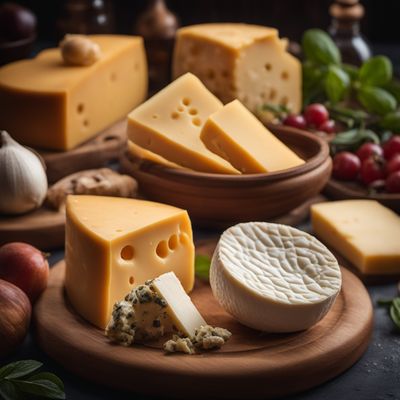
Ingredient
Cheese, gjetost
The Sweet and Nutty Delight: Exploring the Unique World of Gjetost Cheese
Gjetost cheese is a dense and creamy cheese that is made from a blend of cow's milk and goat's milk whey. It has a distinctive brown color and a smooth, fudge-like texture. The cheese has a sweet and nutty flavor with hints of caramel and butterscotch. Its unique taste and texture make it a versatile ingredient in both traditional and modern recipes.
Origins and history
Gjetost cheese has its origins in Norway, where it has been produced for centuries. It was traditionally made by simmering whey leftover from the production of other cheeses until it caramelized and thickened. This process gave the cheese its characteristic sweet flavor and brown color. Gjetost cheese has deep cultural significance in Norway and is often enjoyed as a part of traditional celebrations and gatherings.
Nutritional information
Gjetost cheese is a good source of protein and calcium. It also contains essential vitamins and minerals, including vitamin A, vitamin B12, and phosphorus. A 1-ounce serving of gjetost cheese provides approximately 130 calories.
Allergens
Gjetost cheese contains milk and may not be suitable for individuals with lactose intolerance or milk allergies.
How to select
When selecting gjetost cheese, look for a well-packaged product with a firm texture and a rich, brown color. Avoid cheese that appears dry or crumbly, as it may indicate poor quality.
Storage recommendations
To maintain the freshness and quality of gjetost cheese, store it in an airtight container in the refrigerator. It can also be wrapped tightly in wax paper or plastic wrap. Properly stored, gjetost cheese can last for several weeks.
How to produce
Gjetost cheese production requires specialized equipment and knowledge. It is best left to experienced cheesemakers, but adventurous individuals can try making it at home using recipes and instructions available online.
Preparation tips
Gjetost cheese can be enjoyed on its own, sliced and served with crackers or bread. It can also be melted and used as a topping for waffles, pancakes, or roasted vegetables. For a sweet treat, gjetost cheese can be spread on toast or used as a filling for pastries. Its unique flavor pairs well with fruits, nuts, and dark chocolate.
Culinary uses
Gjetost cheese is commonly used in Scandinavian cuisine. It is often grated or sliced and used as a topping for open-faced sandwiches, known as smørrebrød. It can also be melted and used as a sauce for pasta or vegetables. In desserts, gjetost cheese adds a rich and sweet flavor to cakes, cookies, and puddings.
Availability
Gjetost cheese is commonly available in Norway and other Scandinavian countries. It can also be found in specialty cheese shops or online retailers that offer international cheeses.
More ingredients from this category » Browse all

Cheese, herrgardost
The Swedish Delight: Herrgardost Cheese

Cheese, smoked gouda
Smokey Dutch Delight

Cheese, danbo
The Danish Delight: Exploring the Savory World of Danbo Cheese

Cheese, hushallsost
The Swedish Delight: Hushallsost - A Creamy and Nutty Cheese

Cheese, cheshire
The Quintessential British Cheese: Exploring the Delights of Cheshire Cheese

Cheese, derby
The Delightful Delicacy: Derby Cheese

Cheese, tetilla
The Creamy Wonder of Tetilla Cheese

Cheese, double gloucester
Rich and Creamy Delight

Cheese, nokkelost
"Nokkelost: The Spiced Delight of Scandinavian Cheeses"

Cheese, nagelkaas
Nagelkaas - The Dutch Delight of Spiced Cheese

Cheese, kasseri
The Greek Melting Marvel: Kasseri Cheese

Cheese, chimay
The Belgian Delight: Chimay Cheese